- Table of Content
- 1.Farmers and sp...
- 2.Review of sola...
- 3.Review of geom...
- 4.Noticeable Sol...
- 5.The Internatio...
- 6.PROBA2 Observa...
- 7.Geomagnetic Ob...
- 8.The SIDC Space...
- 9.Action!
2. Review of solar activity
3. Review of geomagnetic activity
4. Noticeable Solar Events (31 Oct 2022 - 6 Nov 2022)
5. The International Sunspot Index by SILSO
6. PROBA2 Observations (31 Oct 2022 - 6 Nov 2022)
7. Geomagnetic Observations in Belgium (31 Oct 2022 - 6 Nov 2022)
8. The SIDC Space Weather Briefing
9. Action!
Farmers and space weather
In the past, space weather centers have created many overviews to highlight sources of disturbed space weather and the domains and industries that may be heavily impacted by it, such as satellites, power grids, and aviation. A small but important sector that is affected by disturbed space weather is farming and agriculture, as shown in the annotated figure underneath that was created by NASA for the AGU 2011 conference (https://www.nasa.gov/mission_pages/sunearth/news/agu2011-spaceweather.html ).
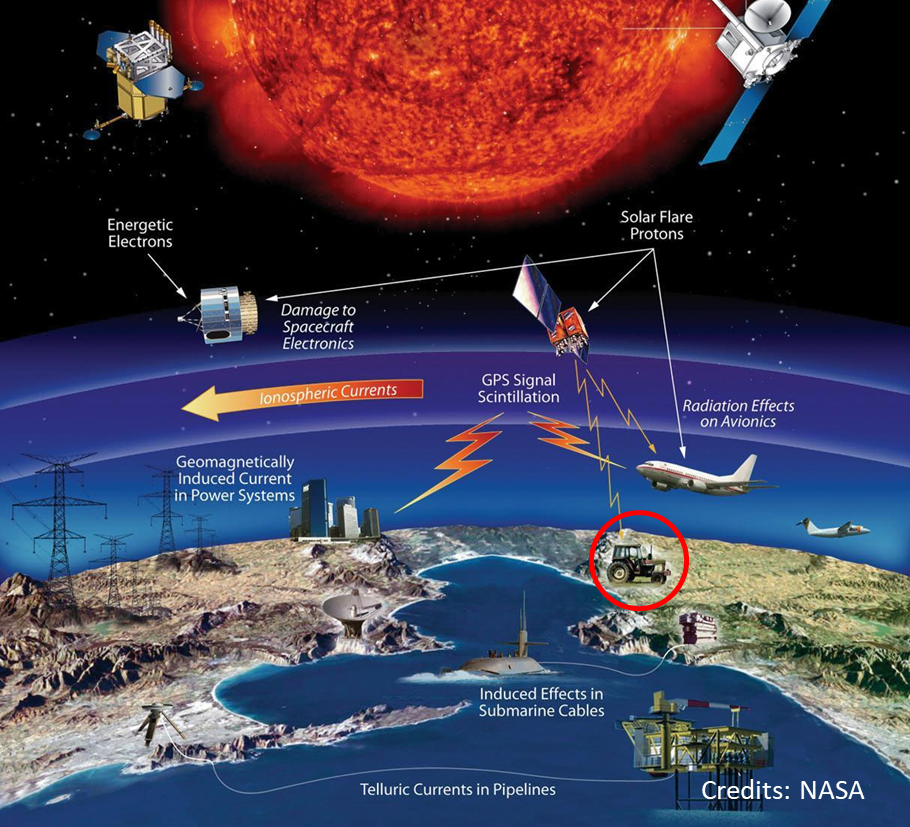
There are easier ways to make a living than the farming business. Aside the hard labour and long working hours, there's also the important influence of occasionally extreme weather conditions, the measures related to climate and environmental issues, diseases (crops and livestock), tough competition (internal and external markets), and so on. During the 1990s, a small but positive evolution took place when GNSS (Global Navigation Satellite System) introduced itself in the agricultural world, thus allowing for an improved positioning, navigation and timing. At that time there was only GPS, but over the next decades satellites from Europe (GALILEO), Russia (GLONASS) and China (BeiDou) further expanded the GNSS network, currently allowing accuracies of less than a few cm. This "Precision Farming" has great benefits for the ranchers such as reduced waste through over-application of fertilisers and herbicides, reduced seed consumption, fuel and time savings, lower fatigue and optimisation of crop yields. It enables 24/7 operations in challenging environments, such as low visibility, and plays an important part in the entire agricultural production cycle as well as livestock monitoring. A recent study indicated that the gains achievable through improved equipment efficiency (working rate) and increased equipment operation (hours) were relatively modest (10-20 euros per hectare), but became significant when large farms are concerned or when summed over states or countries.
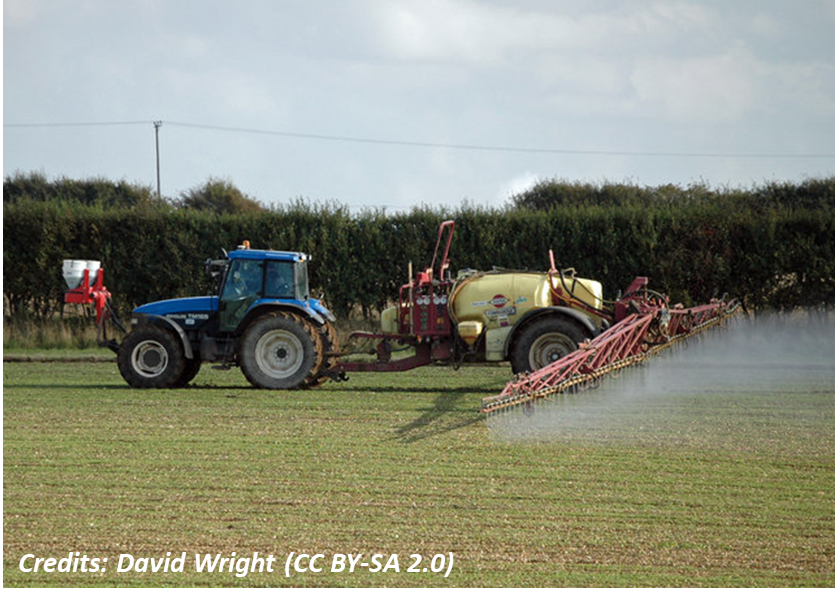
The increased use of these GNSS applications also means that the precision agriculture (PA) also suffers from the effects that adverse space weather (SWx) conditions may have on GNSS technologies. In particular all SWx sources that may cause ionospheric scintillation, such as strong solar flares and geomagnetic storms, are to be watched. Ionospheric scintillation is the rapid modification of radio waves when they travel through a region of small scale irregularities in electron density in the ionosphere (see sketch underneath as well as this STCE newsitem at https://www.stce.be/news/420/welcome.html ). Severe scintillation conditions can prevent a GNSS receiver from locking on to the satellite's signal and can make it impossible to calculate a position. Less severe scintillation conditions can reduce the accuracy and the confidence of positioning results.
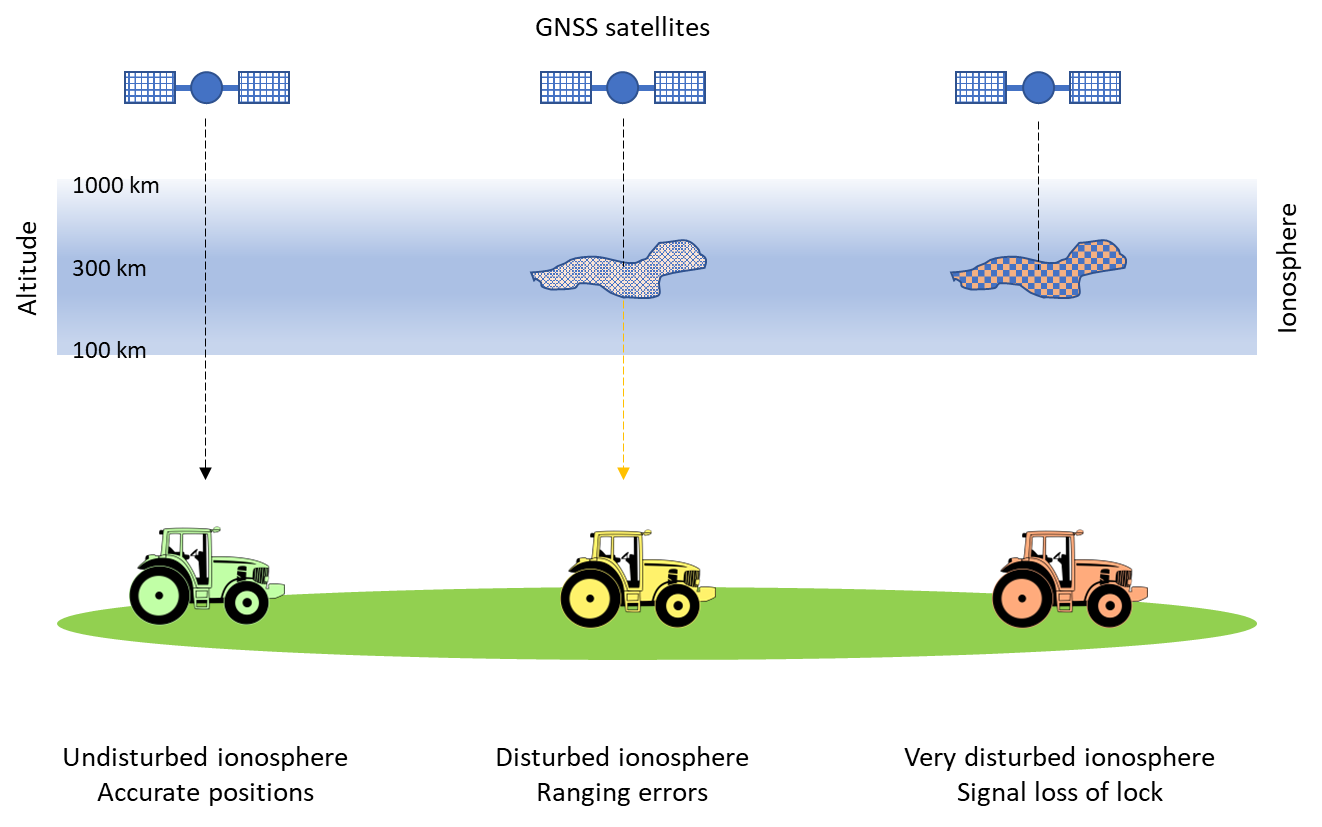
Ionospheric scintillation is primarily an equatorial and high-latitude ionospheric phenomenon, although it can (and does) occur at lower intensity at all latitudes. This is shown in the map underneath with darkest colors representing strong ionospheric scintillation for constant local time at all longitudes. The reported issues, i.e. loss-of-lock and degraded position accuracy, are heavily affecting precision farming. Interestingly, a 2022 study showed that the continental United States (CONUS) have observed very few instances of scintillation on commercial PA systems. This may be due to a lack of reporting or issue recognition. Ionospheric scintillation induced issues are common in Brazil which is most likely due to the combination of its low-magnetic latitude location and increasing adoption of PA. The study calculated that for the Mid-West United States (Illinois, Indiana, Iowa, and Ohio), the regional economic loss due to a GNSS outage at a critical timing (e.g. during seeding/planting season) can run into several tens of millions of dollars. Though this looks like a big number, it amounts only to a few percent of yield loss. Nonetheless, while small, it could mean the difference between profit and loss for smaller operators, especially in years with more adverse economic conditions. Thus, extreme conditions, as well as low-latitude scintillation, remain issues that require improved mitigation techniques. One of the possible actions to keep farming operations going during a sudden GNSS outage is for example to fall back on the ground-based radio positioning technology that was used a couple of decades ago. Another option is to plan for the unexpected, and talk with financial advisors and equipment dealers to discuss back-up options. Raising awareness of the scintillation problems, and improving the scintillation nowcast and forecast systems, are just a few of the other actions than can be worked upon, in particular considering the upcoming maximum of solar cycle 25.
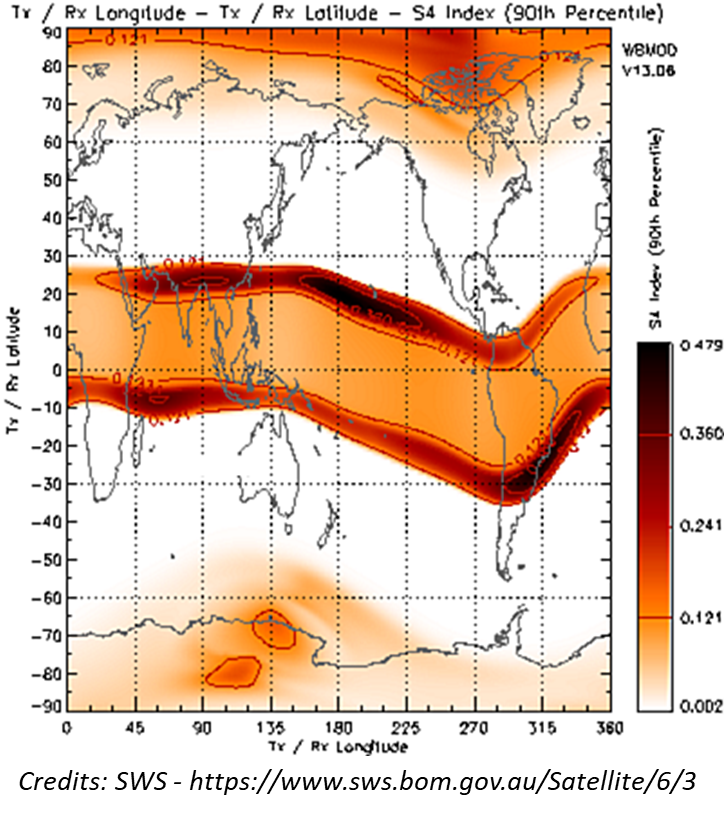
Sources and further reading - This article was compiled from the report related to "Space Environment Engineering and Science Applications Workshop - Ionospheric Impacts: Precision Applications (Precision Agriculture)" from early 2022 (Kansas State University - https://agmanager.info/news/recent-videos/global-cost-assessment-gnss-outage-agricultural-productivity ), as well as from newsitems from NASA (https://earthobservatory.nasa.gov/features/PrecisionFarming ) and ESA (https://www.esa.int/Applications/Observing_the_Earth/Copernicus/Bringing_satellite_data_to_farmers and https://www.esa.int/Applications/Observing_the_Earth/Taking_farming_into_the_space_age ), and from various other media reports such as Eurisy (https://www.eurisy.eu/gnss-leads-the-way-in-precision-farming_11/ ), Euspa (https://www.euspa.europa.eu/newsroom/news/egnos-gets-precise-poland ), EGSC (https://www.gsc-europa.eu/news/european-gnss-proves-powerful-in-the-farming-field-3 ), and Future Farming (https://www.futurefarming.com/tech-in-focus/case-ih-rtk-auto-steering-now-also-uses-galileo-gps/ ).
Review of solar activity
Over the past week the solar flaring activity was at low levels with mostly low C-class flaring. There were twelve numbered active regions on the visible disk, which produced 21 C-class flares. The strongest flare over the week was a gradual C5.6-class flare, peak time 07:44 UTC on Nov 4th, produced from behind the north-east limb, most probably from NOAA AR 3141. The largest and most complex active regions producing most of the flaring activity throughout the week were NOAA 3135 and NOAA 3141 (beta). Both regions had large pronounced leading and trailing spots. NOAA AR 3135 had shortly increased its complexity to beta-gamma on Nov 1st, but quickly after declined back to magnetic type beta. Despite its complexity the region produced only occasional low C-class flaring. NOAA AR 3141 produced background low levels of activity towards the end of the week. The remaining active regions were either small and simple, or predominantly stable and inactive.
The solar surface was streaked by filaments and multiple eruptions were observed throughout the week, including a large filament eruption on Nov 4th. None of these events resulted in an Earth-directed coronal mass ejection (CME). A low C1.4-flare, peak time at 07:23 UTC on Nov 3rd, produced by NOAA AR 3136 (beta) caused a strong on disc dimming, but the related CME was estimated to miss Earth.
The greater than 10 MeV proton flux was at nominal levels throughout the entire week. The greater than 2 MeV electron flux started at elevated levels crossing the 1000 pfu threshold for prolonged periods of time in the beginning of the week. The greater than 2 MeV electron flux further increased to be strictly above the 1000 pfu threshold from Nov 4th onwards. The corresponding electron fluence was at moderate levels throughout the entire week.
Review of geomagnetic activity
The solar wind parameters were enhanced through most of the week due to several high speed stream (HSS) arrivals from different positive polarity coronal holes. The solar wind velocity reached a maximum of 638 km/s. The interplanetary magnetic field went up to 10.7 nT and the minimum value of the Bz component was -10.45 nT. The interplanetary magnetic field was predominantly in the positive sector (directed away from the Sun) throughout the entire week, reflecting the polarity of the geo-effective coronal holes.
The geomagnetic conditions over Belgium throughout the week were mostly quiet to unsettled with few isolated active periods in the afternoon of Nov 4th. The global geomagnetic conditions as measured by NOAA Kp index were quiet to active with two isolated minor storm levels in the afternoon of Nov 4th in response to a HSS arrival.
Noticeable Solar Events (31 Oct 2022 - 6 Nov 2022)
| DAY | BEGIN | MAX | END | LOC | XRAY | OP | 10CM | TYPE | Cat | NOAA |
| 06 | 2359 | 0011 | 0016 | M5.2 | 89 | 3141 |
| LOC: approximate heliographic location | TYPE: radio burst type |
| XRAY: X-ray flare class | Cat: Catania sunspot group number |
| OP: optical flare class | NOAA: NOAA active region number |
| 10CM: peak 10 cm radio flux |
The International Sunspot Index by SILSO
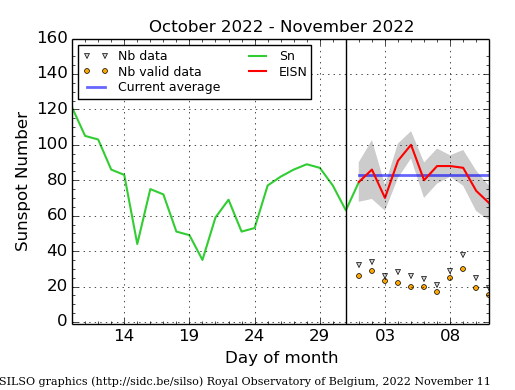
The daily Estimated International Sunspot Number (EISN, red curve with shaded error) derived by a simplified method from real-time data from the worldwide SILSO network. It extends the official Sunspot Number from the full processing of the preceding month (green line), a few days more than one solar rotation. The horizontal blue line shows the current monthly average. The yellow dots give the number of stations that provided valid data. Valid data are used to calculate the EISN.
PROBA2 Observations (31 Oct 2022 - 6 Nov 2022)
Solar Activity
Solar flare activity fluctuated from very low to moderate during the week.
In order to view the activity of this week in more detail, we suggest to go to the following website from which all the daily (normal and difference) movies can be accessed: https://proba2.oma.be/ssa
This page also lists the recorded flaring events.
A weekly overview movie can be found here (SWAP week 658). http://proba2.oma.be/swap/data/mpg/movies/weekly_movies/weekly_movie_2022_10_31.mp4
Details about some of this week's events can be found further below.
If any of the linked movies are unavailable they can be found in the P2SC movie repository here
https://proba2.sidc.be/swap/data/mpg/movies/
Friday Nov 04
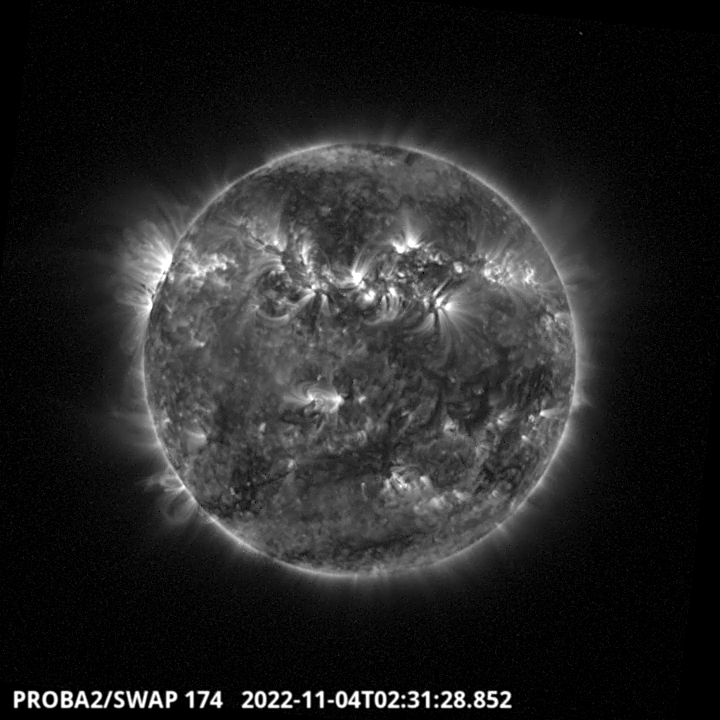
A filament erupted in the South West hemisphere around 02:31 UT - SWAP image
Find a movie of the events here (SWAP movie) https://proba2.sidc.be/swap/data/mpg/movies/20221104_swap_movie.mp4
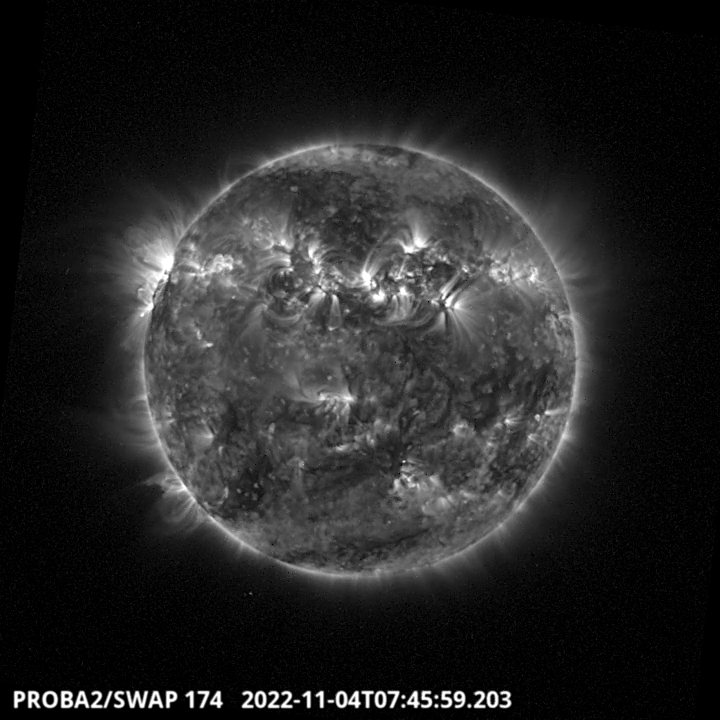
The largest flare of the week, a C5.6 flare, has been produced by the active region NOAA 3141
around 7:45 UT - SWAP image. Find a movie of the events here (SWAP movie)
https://proba2.sidc.be/swap/data/mpg/movies/20221104_swap_movie.mp4
Geomagnetic Observations in Belgium (31 Oct 2022 - 6 Nov 2022)
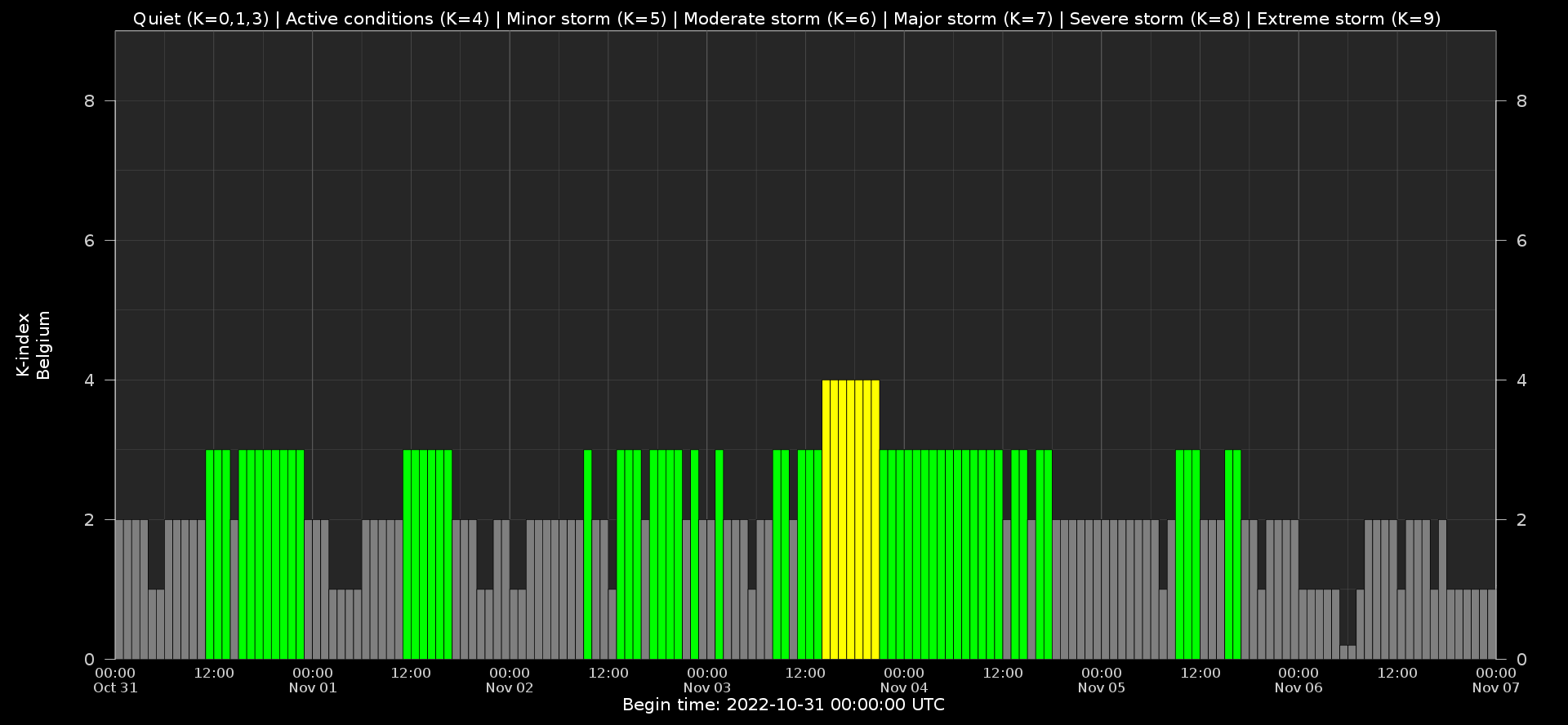
Local K-type magnetic activity index for Belgium based on data from Dourbes (DOU) and Manhay (MAB). Comparing the data from both measurement stations allows to reliably remove outliers from the magnetic data. At the same time the operational service availability is improved: whenever data from one observatory is not available, the single-station index obtained from the other can be used as a fallback system.
Both the two-station index and the single station indices are available here: http://ionosphere.meteo.be/geomagnetism/K_BEL/
The SIDC Space Weather Briefing
The Space Weather Briefing presented by the forecaster on duty from Oct 30 to Nov 6. It reflects in images and graphs what is written in the Solar and Geomagnetic Activity report: https://www.stce.be/briefings/20221107_SWbriefing.pdf
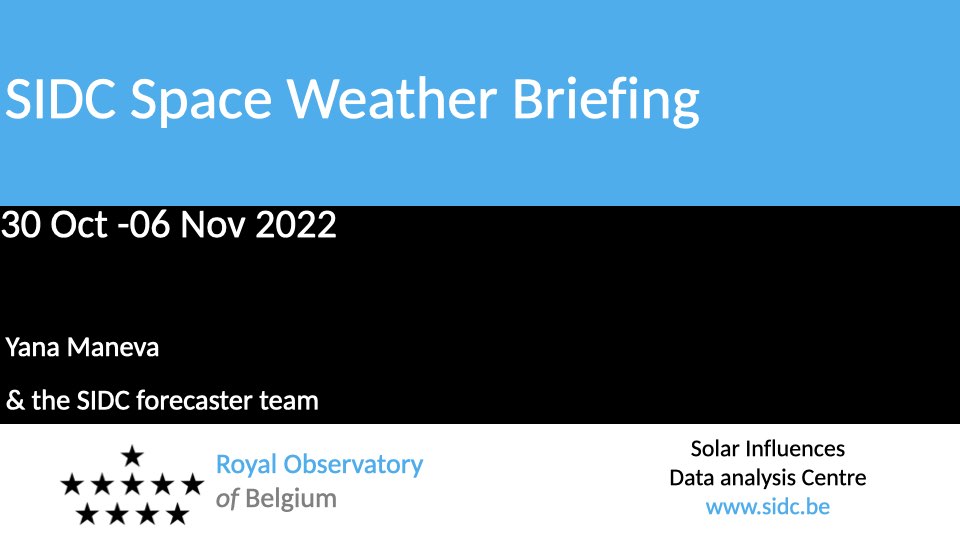
If you need to access the movies, contact us: stce_coordination at stce.be
Action!
Check out our activity calendar: activities and encounters with the Sun-Space-Earth system and Space Weather as the main theme. We provide occasions to get submerged in our world through educational, informative and instructive activities.
If you want your event in our calendar, contact us: stce_coordination at stce.be
* November 21-23, Space Weather Introductory Course - onsite, by the STCE, Brussels, Belgium - fully booked
* November 22, seminar: Ionospheric Disturbances Detection by HF Doppler sounding, onsite and online, STCE
* November 27, Dag van de Wetenschap, Planetarium, Belgium
* December 5, 6, 8, 9, Space Weather Introductory Course - online, by the STCE, zoom - fully booked
Check: https://www.stce.be/calendar
